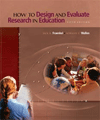 |  How to Design and Evaluate Research in Education, 5/e Jack R. Fraenkel,
San Francisco State University
Norman E. Wallen,
San Francisco State University
Validity and Reliability
Learning ObjectivesStudying this chapter should enable you to:
| Explain what is meant by the term "validity" as it applies to the use of instruments in educational research. |
 |  |  | | Name three types of evidence of validity that can be obtained, and give an example of each type. |
 |  |  | | Explain what is meant by the term "correlational coefficient" and describe briefly the difference between positive and negative correlation coefficients. |
 |  |  | | Explain what is meant by the terms "validity coefficient" and "reliability coefficient." |
 |  |  | | Explain what is meant by the term "reliability" as it applies to the use of instruments in educational research. |
 |  |  | | Explain what is meant by the term "errors of measurement." |
 |  |  | | Explain briefly the meaning and use of the term "standard error of measurement." |
 |  |  | | Describe briefly three ways to estimate the reliability of the scores obtained using a particular instrument. |
 |  |  | | Describe how to obtain and evaluate scoring agreement. |
|



 2003 McGraw-Hill Higher Education
2003 McGraw-Hill Higher Education